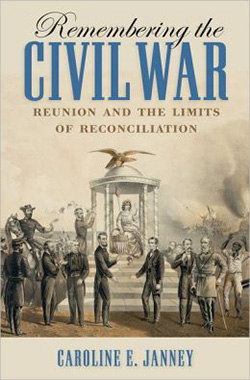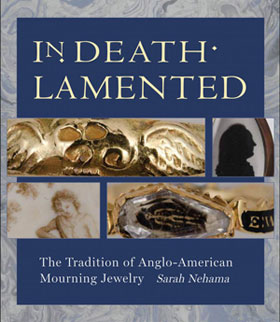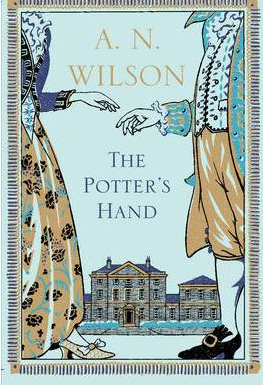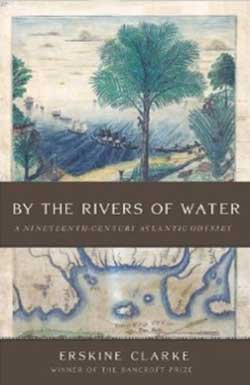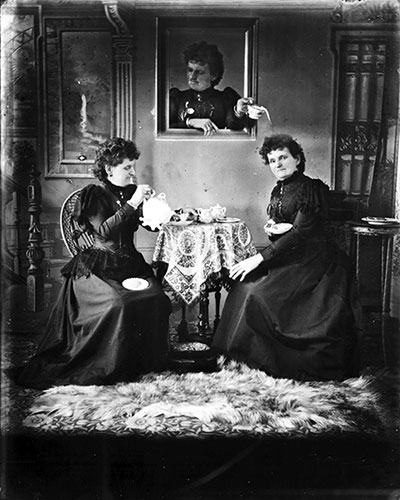Under Household Government
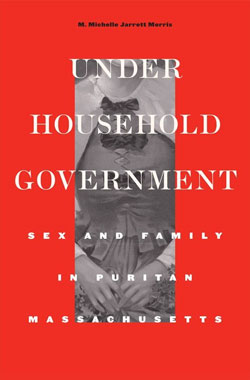
Sex and Family in Puritan Massachusetts
Common-place asks Michelle Morris about her 2013 book, Under Household Government: Sex and Family in Puritan Massachusetts, and the role of family members in policing sexual conduct in early New England, which shows how ordinary colonists understood sexual, marital, and family relationships.
One of the central arguments of your book is that the policing of sexual behavior (sexual offenses in particular) took place primarily within the bounds of family, and often resulted in contests between families. What led you to this conclusion, rather than seeing the phenomenon as one chiefly of community surveillance?
I came to that conclusion in a rather roundabout way. Indeed, the case that was initially crucial to my thinking never appears in the book. I had initially intended to focus my project on motherhood in colonial America, and had also wanted to take advantage of New England’s rich cache of court records. I eventually realized that my topic and my source base did not work well together—motherhood, after all, is not a crime—but not before I came across the case of Mary Flood, a married woman who was accused of murdering her infant in 1686. When Goody Flood awoke at dawn to find that the child lying next to her was dead, her cries touched off a progression of visitors to her chamber until the final visitor notified the constable, who arrested Flood. I had been interested in the relationships between women giving birth and the women who attended them. Did women call personal friends, those who were known to be especially gifted in aiding birthing mothers, or simply their nearest neighbors? With this case, I started with a similar question: whom do you call when you wake up in the morning to find your child dead? I mapped out the homes of those who responded to the infanticide and was surprised to find that they lived all over town. So much for nearest neighbors. And then I was stuck. The file papers were rich in detail about the scene in the Floods’ home and Mary Flood’s treatment of her infant, but they had little to say about why particular individuals were summoned or felt the need to visit the scene. I needed to get to know these visitors better. I needed clues.
I turned to the New England Historical and Genealogical Society. Genealogies usually give brief summaries of whatever is known about their subjects, and New Englanders have been obsessed with their ancestors for centuries. I thought maybe I would find that one of the visitors was a midwife. Maybe the group was held together by some sort of craft organization. I piled mounds of genealogies on the long wooden tables, but it was not looking good. The people seemed to have nothing in common but their presence in Mary Flood’s chamber. But then I started to notice something: I was seeing the same last names over and over as I flipped through to find the individuals I was looking for, and so I started to see if I could bring family connections together in a coherent way. Sure enough, although the first visitors had been co-workers of the Floods or people who shared the Flood house, the later visitors were all members of the same extended family. Each new visitor was related to the last, and each was of a slightly higher status than the one before. Only the very last, a woman married to a wealthy stonemason and landowner, seemed to have the clout to take control of the situation and summon the constable.
As I transitioned to a project on illicit sexual activity, spurred by court records, I wondered if similar familial patterns might appear. I was quite surprised by what I found. I expected families to monitor, intervene, and testify about illicit sexual activities. It would have been odd if they had not done so. What I did not expect to find was that family relationships dominated and structured the trials. In nearly all of the cases I investigated, most (and sometimes all) of the deponents were either family members of those involved or had an identifiable personal stake in the outcome of the case. Given that our knowledge of family connections and personal quarrels is obviously incomplete, the consistency with which these connections appeared astounded me. What surprised me almost as much was the lack of non-familial intervention. Although neighbors sometimes testified in these cases, they usually testified about behavior they had observed; only very rarely did unrelated deponents claim to have tried to intervene in suspicious sexual behavior.
It did occur to me that what I was seeing might have as much to do with the density of family networks as it did with family members taking the lead in dealing with illicit sexual activity. After all, if almost everyone in a village was related to almost everyone else, then deponents and defendants could hardly help being related! Thank goodness for town genealogies. I tried several times to choose two people from the same town with different last names and make kinship connections. Although I could occasionally find a relationship that way, the vast majority of the pairs refused to connect. That really changed the way I thought about family and community in early New England. I had always envisioned a watchful society in which individuals considered their neighbors’ sins to be community business. It was only then that I thought back to Edmund Morgan’s work and his conclusion that “tribalism” (an intense and exclusive focus on the good of one’s family) had undermined the Puritans’ evangelical mission, and I realized that what I was seeing was another consequence of tribalism run amok.
As the introduction and conclusion make clear, Under Household Government is in conversation with Edmund Morgan’s now-canonical The Puritan Family. What does your book share with his book, and where does it build on or depart from it?
Edmund Morgan’s The Puritan Family mapped new ground when it was first published in the 1940s, and I do not think it is possible to write about the Puritan family today without building on Morgan’s work. The Puritan Family and Under Household Government share two essential conclusions: that New England’s Puritans believed families to be central to the way their society was organized, and that the Puritans’ intense devotion to their families ultimately undermined important social goals.
But Under Household Government is not merely an updated version of Morgan’s work. The books’ approaches differ in important ways. Morgan focused primarily on how New Englanders expected their families to work. Although The Puritan Family does include examples of family relationships gone wrong and familial duties unfulfilled, even these examples serve to explicate the ideal Puritan family. Morgan teaches us about the balance of order, hierarchy, and love the Puritans strove to achieve. My work, on the other hand, deals with families in crisis; it is more about how families actually worked than it is about how family members thought they should work. It might help to think about Under Household Government as the dark side of The Puritan Family. Morgan and I share a lot of the same type of sources, but the distribution of those sources is telling. Morgan’s archetypical source is a sermon; mine is a deposition.
You have much to say about the power of patriarchy generally, and of specific patriarchs in particular. How do you think your book fits with historian Toby Ditz’s rendering of the history of masculinity as one of power through access to women?
I think Ditz’s primary concern—that histories of masculinity have the potential to simply re-inscribe a dominant male narrative by neglecting the ways in which masculine power has been predicated on the subjection of women—is particularly insightful. In my book, I build on Thomas Foster’s work, which emphasizes the ways in which patriarchal status (the goal of fully developed adult manhood) depended directly and literally on access to women. As I explain in my book, the gateway to adulthood in seventeenth-century New England was built around marriage. Only by marrying and setting up independent households could men (and women) access the power that came with adulthood. Unmarried men, even those who were above what we consider the age of majority, were primarily sons or servants until they wed. Because most men in seventeenth-century New England married, the connection between marriage, adulthood, and patriarchy was not always obvious. We see it most clearly in cases in which men’s right to marry was called into question because of an inability to perform sexually.
The best example of this from my book is the tale of “Goodman Mousall’s Diabolical Erection” (chapter 3). In this 1663 case, John Foskett told John Mousall that “all that he [Mousall] had was the devil’s for he stood by his bedside and caused his members [penis] to rise” and that “the devil would have him and all that he had at the last.” The insult does not make much sense unless we understand the instinctive connection between masculine privilege and access to women. Foskett had reason to be insecure about his own masculine privilege. Although he was married, he lived with his wife’s parents. When Mousall’s wife, Elizabeth, challenged Foskett’s authority over dependents in both of their households, Foskett physically and verbally attacked both of the Mousalls. Because the Mousalls had a daughter, Foskett did not simply accuse John Mousall of being impotent. Instead, he challenged Mousall’s right to all of the trappings of patriarchal authority by claiming that his erections (a legal prerequisite for marriage) were not really his own.
Ditz, of course, also notes that the ways in which male power rests on access to women is not monolithic. It is complicated and historically specific. This is particularly true of marriage in early America. The ways in which men accrued power by marrying women are obvious. Patriarchal status depended on a man’s ability to marry and set up an independent household. The law of coverture gave a husband the right to all of the property and wages his wife had or might earn. A husband had a right to his wife’s labor and her sexual service. Yet women married willingly. They did so for a number of reasons: a lack of economic options, the desire for sexual satisfaction and companionship, social expectations, etc. Just as importantly, women, like men, derived a measure of authority and independence by marrying. It is significant that John Foskett’s attack on John Mousall was prompted by Elizabeth Mousall’s assertion of authority. Elizabeth might have been second in command to her husband, but in his absence she had the right to direct and control access to dependents in her household. In that sense, women like Elizabeth Mousall actually had a stake in preserving a patriarchal system that ultimately relied on their subjection.
You open with the phrase “This is a story …” and many rich stories appear within the larger narrative. As you immersed yourself in the lives of seventeenth-century residents of New England, getting to know them (as far as possible) in the process, did you experience a particular affinity for any of them?
Edmund Parker. I think I fell in love with the crotchety old man from Lancaster, Massachusetts. Parker is a relatively peripheral character in the first chapter of my book. His daughter Elizabeth was a servant who engaged in intercourse with an enslaved black man and bore a child. Edmund took both his daughter and her mixed-race son into his household and, despite his own poverty, refused to allow either local or county officials to separate them. He did not have a lot to work with. He had neither wealth nor position, and the law was not on his side. The document that hooked me was a petition from the selectmen who had tried to remove Elizabeth and her son from Edmund’s house. The selectmen complained that they “have had many froward peevish expressions from him, so that he hath wearied them out.” I cannot help but imagine the old man standing on his own doorstep, telling the selectmen who wanted to take away his daughter and grandson precisely what they could do with themselves, and then slamming the door in their faces. That’s my kind of grit.
I did become emotionally invested in a lot of the people in my book—in both positive and negative ways. I can hardly think about Jonathan Wade, who purchased Elizabeth Parker’s enslaved partner, without my lip curling in disgust. If you want to know why, he’s in chapter 1 as well. The procession of sexually abused children certainly got to me. Seventeenth-century court records tend to be emotionally unexpressive by modern standards, but once you become accustomed to the style of testimony, it’s sometimes all too easy to pick up on the emotion behind the dry recitations. I remember working one day on the Elizabeth Pierce chapter and setting up the section on the rape of minors. I worked my way through the descriptions of the injuries wrought by actual and attempted rape. Then I came to the case of Scisely, an Indian child under the age of ten. The woman who examined her testified that Thomas Keeney had been unable to rape her because her body was too small. The woman testifying wrote that Scisely was “as greatly wronged otherwise as is imaginable.” Seventeenth-century folk did not refer to imagination very often in court records. I put down my coffee, put my head in my hands, finally looked up and closed my laptop. It was before noon, but I found that I had had all the work I could take for that day.
If, however, by “affinity” you mean someone I could identify with, then the answer has to be Elizabeth Wells, who appears in the book’s final chapter. Elizabeth came to a bad end. She claimed rape but was prosecuted for fornication because she became pregnant. She landed in prison and then ended up on the streets. She had loudly proclaimed to all who would listen that if she ever became pregnant, she would name a rich man as the father of her child. She became pregnant, and she named her master’s son. But the reason I feel kinship with Elizabeth is that she was a teller of stories. Many of them were racy; several put her in a rather bad light; and I don’t think half of them were true, but I, too, love a good story.
To build on the issue of subjectivity and your relationship to your research: as you painstakingly reconstructed court cases, you must have formulated your own judgments about them. Sometimes you reveal those to the reader (as in the case of one free black servant woman’s infant, likely murdered by her mistress), and other times not (as in the case of the rape of Elizabeth Pierce). How did you decide when to disclose, even gingerly, your own “verdict” and when to remain more “neutral”?
My impulse is always to “solve the mystery.” The most important factor in sharing or withholding my own judgments was the evidence I had to work with. In most cases, if I thought I had enough evidence to figure out what happened, I shared my “verdict” with the reader and laid out my evidence so that readers could decide whether they agreed. In many cases, the evidence allowed for a pretty clear verdict. In others (particularly the premarital fornication cases, which turned on the physical descriptions of newly delivered infants) the evidence was so sparse or contradictory as to make any conclusions little more than guesswork. What drove me crazy were the cases in the middle. For example, did Edmund Pinson, the hopelessly obtuse suitor from chapter 3, marry his bride without her parents’ consent? In my mind, the question came down to the absence or presence of a nail the bride’s mother might have given Edmund so that he could post notice of his intention to marry on the meeting house door. I can imagine the case going either way, but I will never know if the nail was there. The answer is not important to the point of the story, but its absence bothers me nonetheless.
The stories about the rape of Elizabeth Pierce (chapter 4), and Zipporah, the free black servant accused of infanticide (chapter 6), are both special cases. Elizabeth Pierce accused Benjamin Simonds of rape, and in so doing set off a dramatic conflict between their two families that resulted in three legal trials. Here, the ambiguity in the story is part of the point. I want readers to understand that Elizabeth’s and Benjamin’s families engaged in extreme behaviors (including jury tampering) without actually knowing what happened between Elizabeth and Benjamin. In their ignorance of the truth, at least, the Pierce and Simonds families were in a position not dissimilar from that of the reader. In this case I do suspect more than I am telling, although my evidence is thin. I do think Benjamin raped Elizabeth, but I don’t think either party was telling the whole truth. Even here, however, I could not resist burying a clue for my readers. If, in my mind, the Pinson case came down to a nail, details of the Pierce case come down to a horse (see footnote 110 for the details).
In the case of Zipporah, my “verdict” is crucial to making sense of the story. I struggled with this case for years. Even a cursory reading of the court documents on which the case is based suggests a dramatic story. A group of people walking along the shore in Boston encounter the corpse of a headless baby. Upon investigation, it turns out that a black servant’s mistress had forced her to deliver her baby in secret and then bury the body of her stillborn child in the middle of the night. A colleague was kind enough to share with me supplementary documents she had located relating to the case, but I still could not put the pieces together. Yes, the outlines supported my larger argument about how families abandoned free servants who became pregnant out of wedlock. Zipporah’s mistress planned to sell her as a slave in the Caribbean. The case bothered me because it was too pat. A secret delivery, a convenient stillbirth due to prematurity, a mistress, her mother, and a midwife willing to testify that no murder had been committed. No reason for the court to pay it any further mind. As I went over and over the evidence, I started to realize that what was really bothering me was that the case did not make sense. All of the legal evidence was there to acquit Zipporah of infanticide, but that was all that was there. None of the witnesses provided the reasoning on which they based their conclusions, which was extremely unusual. No one appears to have asked who the father of the child was. The more I looked at the evidence, the more it fell apart. I had approached the documents the same way I approached all my cases—assume everyone is telling the truth until there is reason to believe otherwise. Usually, the clue that someone lied comes from disparities among the depositions. In this case, the testimony was all consistent. When I turned my first assumption on its head, however, and assumed that all of the women in the birthing room were lying about the stillbirth, the pieces started to fall into place. No one asked who the father of the baby was because he was a member of the family, and that baby was neither premature nor stillborn. In this case, a cursory reading of the documents did illustrate the point I was making. Masters and mistresses did usually abandon free servants if they became embroiled in sexual scandal by, for example, getting pregnant. Enslaving a servant and shipping her off to Barbados was a rather extreme version of that pattern, but “solving the mystery” and sharing that with my readers allowed me to demonstrate just how dark the impulse to get rid of inconvenient servants and protect family members could be.
It is that inward-looking devotion to family that is really at the heart of my book. On the surface, it is hard to imagine how strong, caring families could be problematic. In many cases, they were not. Parents and other family members watched over their sons and daughters, attempting to steer their children away from sexual sin and into strong, stable marriages. Those who lived under the watchful gaze of dense family networks may sometimes have resented prying eyes, but families were usually successful at steering younger members away from sexual crimes which could bring harsh legal consequences and damage marital prospects. Problems arose when families interacted with members of the community with whom they did not share ties of kinship. Sometimes, as was the case with Zipporah, these were servants within their own homes. Other times, such as in the Elizabeth Pierce case, those community members were part of other families. The early leaders of the Massachusetts Bay colony had gone to great lengths to set up a system of justice which would protect the rights of the accused and ensure both poor and wealthy access to impartial courts. Secular justice in the abstract was an important ideal in colonial Massachusetts. However, seventeenth-century communities lacked anything resembling a modern police force which might have played an investigative or mediating role, and the community at large was generally unwilling to fill the breach (at least in cases relating to sexual activity). The result was that court trials often played out as battles between competing families, and those families tended to put the needs of their own members before more abstract ideals of justice.

